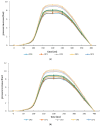The Use of Wood Pellets in the Production of High Quality Biocarbon Materials
- PMID: 35806529
- PMCID: PMC9267371
- DOI: 10.3390/ma15134404
The Use of Wood Pellets in the Production of High Quality Biocarbon Materials
Abstract
Biomass is one of the most important sources of renewable energy. One of the most widely used biomass biofuels is wood pellets. It is an economical, homogeneous and easy-to-use raw material. Biomass is used to generate low-emission energy utilizing the pyrolysis process. Pyrolysis allows for higher energy efficiency with the use of commonly available substrates. This thesis presents the results of research on the possibility of using the pyrolysis process to produce high-energy biocarbons from wood pellets. Data on basic energy parameters and explosivity of biocarbon dust were compiled as criteria for the attractiveness of the solution in terms of energy utility. The research used pellets made of oak, coniferous, and mixed sawdust, which were subjected to a pyrolysis process with varying temperature and time parameters. Carbon, ash, nitrogen, hydrogen, volatile substances, heavy metals, durability and calorific value of the tested materials were carried out. The highest increase in calorific value was determined to be 63% for biocarbons obtained at 500 ℃ and a time of 15 min, compared with the control sample. The highest calorific value among all analyzed materials was obtained from coniferous pellet biocarbon at 31.49 MJ kg-1. Parameters such as maximum explosion pressure, Pmax, maximum pressure increase over time, (dp/dt)max, and explosion rates, Kst max, were also analyzed. It was noted that biomass pyrolysis, which was previously pelletized, improved the energy parameters of the fuel and did not increase the risk class of dust explosion. The lowest and highest recorded values of Kst max for the analyzed materials were 76.53 and 94.75 bar s-1, respectively. The study concluded that the process used for processing solid biofuels did not affect the increase in the danger of dust explosion. The results presented in this article form the basis for further research to obtain detailed knowledge of the safety principles of production, storage, transport and use of these new fuels.
Keywords: calorific value; dust; explosibility; pyrolysis; wood pellet.
Conflict of interest statement
The authors declare no conflict of interest.
Figures






References
-
- Saletnik B., Zaguła G., Bajcar M., Tarapatskyy M., Bobula G., Puchalski C. Biochar as a Multifunctional Component of the Environment. Review. Appl. Sci. 2019;9:1139. doi: 10.3390/app9061139. - DOI
-
- Niedziółka I., Szpryngiel M. Possibilities of using biomass for energy purposes. Agric. Eng. 2014;1:155–164.
-
- Retajczyk M., Wróblewska A. Pyrolysis of biomass as a source of energy. Wiadomości Chem. Pol. Tow. Chem. 2018;72:127–146.
-
- Malińska K. Biochar–A response to current environmental issues. Politech. Częstochowska Inst. Inżynierii Środowiska. 2012;15:387–403.
-
- Civitarese V., Acampora A., Sperandio G., Assirelli A., Picchio R. Production of Wood Pellets from Poplar Trees Managed as Coppices with Different Harvesting Cycles. Energies. 2019;12:2973. doi: 10.3390/en12152973. - DOI
LinkOut - more resources
Full Text Sources
Research Materials
Miscellaneous

